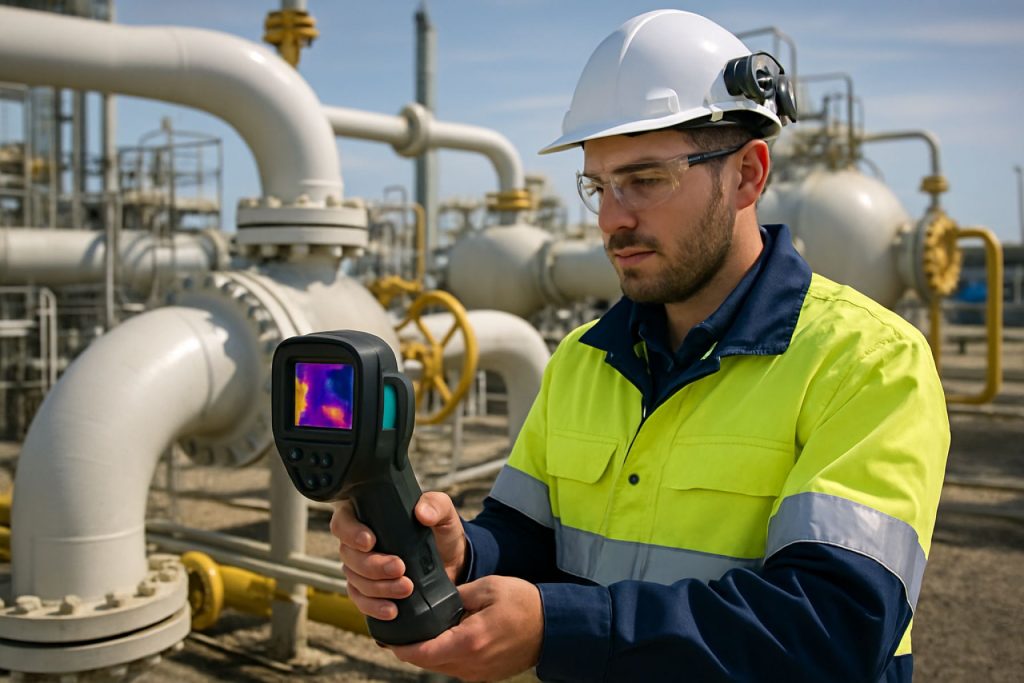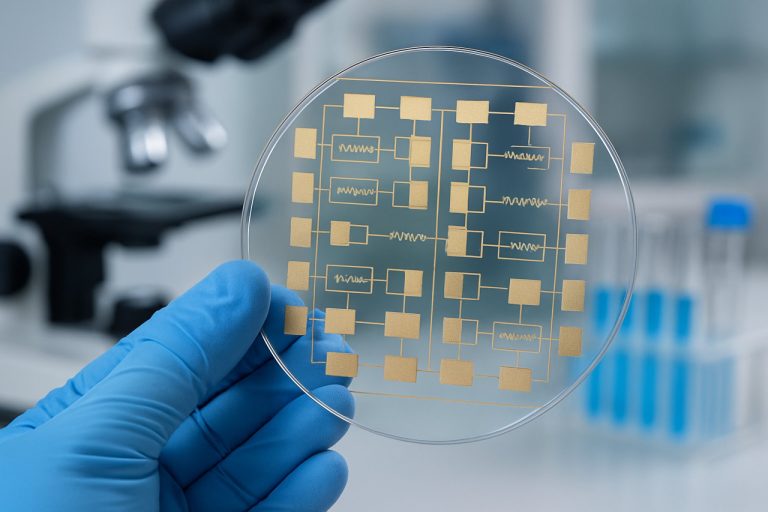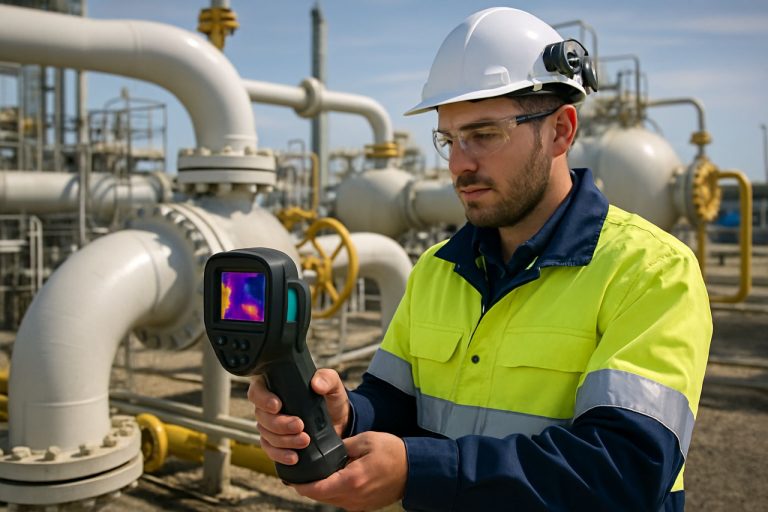
Fugitive Gas Leak Detection Technologies in 2025: How Advanced Sensing, AI, and Regulation Are Transforming Industrial Safety. Explore the Innovations and Market Forces Shaping the Next Five Years.
- Executive Summary: Key Trends and Market Drivers
- Regulatory Landscape and Compliance Requirements (2025–2030)
- Market Size, Growth Forecasts, and Regional Analysis
- Emerging Detection Technologies: Sensors, Drones, and AI Integration
- Competitive Landscape: Leading Companies and Strategic Initiatives
- Case Studies: Industrial Applications and Success Stories
- Challenges: Technical, Operational, and Environmental Barriers
- Investment, M&A, and Startup Activity in Leak Detection
- Future Outlook: Innovation Roadmap and Market Opportunities
- Appendix: Methodology, Glossary, and Company Profiles
- Sources & References
Executive Summary: Key Trends and Market Drivers
The landscape of fugitive gas leak detection technologies is undergoing rapid transformation in 2025, driven by tightening environmental regulations, heightened investor scrutiny, and the global push for decarbonization. Methane, a potent greenhouse gas, remains a primary focus, with regulatory bodies such as the U.S. Environmental Protection Agency (EPA) and the European Union mandating stricter leak detection and repair (LDAR) protocols for oil, gas, and chemical industries. This regulatory momentum is compelling operators to adopt advanced detection solutions that offer higher sensitivity, faster response times, and improved cost efficiency.
Key trends shaping the sector include the accelerated deployment of continuous monitoring systems, the integration of artificial intelligence (AI) and machine learning for data analytics, and the proliferation of remote sensing technologies. Fixed and mobile sensors, including laser-based open-path detectors and tunable diode laser absorption spectroscopy (TDLAS), are increasingly being installed at critical infrastructure points. Companies such as Honeywell and Siemens are at the forefront, offering comprehensive gas detection portfolios that combine traditional point sensors with networked, cloud-enabled platforms for real-time monitoring and predictive maintenance.
A significant development in 2025 is the mainstream adoption of aerial and satellite-based methane detection. Firms like Satellogic and GHGSat are providing high-resolution, spaceborne monitoring services, enabling operators and regulators to pinpoint leaks across vast and remote assets. These technologies are complemented by drone-based solutions from companies such as DJI, which are being integrated with advanced optical gas imaging (OGI) cameras and AI-driven analytics for rapid, large-scale surveys.
The market is also witnessing increased collaboration between technology providers and energy companies to pilot and scale next-generation solutions. For example, Baker Hughes and SLB (formerly Schlumberger) are investing in digital platforms that aggregate multi-source leak data, automate reporting, and support compliance with emerging standards. These partnerships are expected to accelerate the commercialization of novel sensor technologies, including quantum cascade lasers and photoacoustic sensors, over the next few years.
Looking ahead, the outlook for fugitive gas leak detection technologies is robust. The convergence of regulatory pressure, stakeholder expectations, and technological innovation is set to drive double-digit growth in adoption rates through the late 2020s. As digitalization and automation become standard, the sector will continue to evolve toward more proactive, data-driven approaches, supporting both emissions reduction targets and operational excellence.
Regulatory Landscape and Compliance Requirements (2025–2030)
The regulatory landscape for fugitive gas leak detection technologies is undergoing significant transformation as governments and industry bodies intensify efforts to curb methane and other greenhouse gas emissions. In 2025, the focus is on stricter compliance requirements, driven by both national regulations and international climate commitments. The United States Environmental Protection Agency (EPA) is implementing updated rules under the Clean Air Act, mandating more frequent and comprehensive leak detection and repair (LDAR) programs for oil and gas facilities. These rules require operators to deploy advanced technologies, such as optical gas imaging (OGI) cameras and continuous monitoring sensors, to identify and mitigate leaks more effectively.
The European Union is also advancing its Methane Strategy, with the European Commission proposing regulations that will require energy companies to conduct regular leak detection surveys and report emissions data transparently. These measures are expected to be enforced by 2025, compelling operators to adopt state-of-the-art detection systems and digital reporting tools. The International Energy Agency (IEA) and the United Nations Environment Programme (UNEP) are supporting these efforts by providing technical guidance and promoting best practices for methane management.
Industry response to these regulatory shifts is evident in the rapid adoption of innovative detection technologies. Companies such as Teledyne FLIR and Siemens are at the forefront, offering OGI cameras and integrated sensor networks that enable real-time leak detection and automated reporting. Honeywell has developed advanced gas cloud imaging and fixed-point sensor solutions, which are being deployed in compliance with new regulatory standards. Additionally, SLB (Schlumberger) and Baker Hughes are integrating digital platforms with detection hardware to streamline compliance documentation and facilitate regulatory audits.
Looking ahead to 2030, regulatory frameworks are expected to become even more stringent, with increased emphasis on continuous monitoring, data transparency, and third-party verification. The trend toward harmonization of standards across jurisdictions will likely drive further innovation and collaboration among technology providers, operators, and regulators. As a result, the market for fugitive gas leak detection technologies is poised for robust growth, with compliance requirements serving as a primary catalyst for investment in advanced solutions.
Market Size, Growth Forecasts, and Regional Analysis
The global market for fugitive gas leak detection technologies is poised for robust growth in 2025 and the following years, driven by tightening environmental regulations, increased focus on operational safety, and the need to minimize greenhouse gas emissions. The sector encompasses a range of technologies, including optical gas imaging (OGI), laser-based sensors, ultrasonic detectors, and advanced IoT-enabled monitoring systems. These solutions are deployed across oil and gas, chemical, power generation, and industrial manufacturing sectors.
North America remains the largest regional market, underpinned by stringent regulatory frameworks such as the U.S. Environmental Protection Agency’s methane emission standards and Canada’s federal methane regulations. The United States, in particular, is witnessing accelerated adoption of advanced leak detection and repair (LDAR) programs, with major operators integrating continuous monitoring and aerial surveillance. Companies like Teledyne FLIR and Honeywell are prominent suppliers, offering OGI cameras and fixed-point sensors widely used in the region.
Europe is expected to see significant growth, propelled by the European Union’s Methane Strategy and the upcoming legislative requirements for energy sector methane monitoring. The region’s emphasis on decarbonization and net-zero targets is fostering demand for both portable and networked leak detection solutions. Key players such as Siemens and Sensirion are active in supplying sensor technologies and integrated monitoring platforms to European utilities and industrial operators.
Asia-Pacific is emerging as a high-growth market, particularly in China, Australia, and India, where rapid industrialization and expanding energy infrastructure are driving investments in leak detection. National oil companies and utilities are increasingly partnering with technology providers to deploy drone-based and satellite-enabled methane detection systems. Companies like Drone Volt and Hikvision are expanding their presence in the region, offering aerial and fixed monitoring solutions.
Looking ahead, the market is expected to benefit from advances in artificial intelligence, edge computing, and data analytics, which are enhancing the accuracy and responsiveness of leak detection systems. The integration of cloud-based platforms and real-time data sharing is anticipated to further accelerate adoption, especially among large-scale operators seeking to comply with evolving regulatory mandates and ESG commitments. As a result, the fugitive gas leak detection technologies market is forecast to experience sustained double-digit growth rates through the late 2020s, with North America and Europe maintaining leadership, and Asia-Pacific rapidly closing the gap.
Emerging Detection Technologies: Sensors, Drones, and AI Integration
The landscape of fugitive gas leak detection is rapidly evolving in 2025, driven by regulatory pressure, decarbonization goals, and the need for operational efficiency. Traditional methods—such as handheld detectors and periodic manual inspections—are increasingly being supplemented or replaced by advanced technologies that leverage sensors, drones, and artificial intelligence (AI).
Sensor technology remains foundational, with continuous monitoring systems now widely deployed at critical infrastructure points. Fixed-point sensors, such as those developed by Honeywell and Emerson Electric, offer real-time detection of methane and other hydrocarbons, providing immediate alerts and supporting compliance with tightening emissions regulations. These sensors are becoming more sensitive and selective, with improvements in laser-based and photoacoustic detection methods enabling lower detection thresholds and reduced false positives.
Aerial detection using drones has seen significant adoption since 2023, with companies like DJI and senseFly (a Parrot company) providing platforms equipped with miniaturized gas sensors and high-resolution cameras. These drones can rapidly survey large or inaccessible areas, identifying leaks that might be missed by ground crews. In 2025, integration of lightweight tunable diode laser absorption spectroscopy (TDLAS) and infrared (IR) sensors on drones is becoming standard, enabling detection of methane plumes at parts-per-million levels. The use of unmanned aerial vehicles (UAVs) is particularly valuable for pipeline networks, storage facilities, and remote well sites.
AI and machine learning are increasingly central to leak detection workflows. Companies such as Siemens and Schneider Electric are embedding AI algorithms into their monitoring platforms to analyze sensor data, video feeds, and environmental parameters in real time. These systems can distinguish between true leak events and background noise, prioritize alerts, and even predict potential leak locations based on historical data and operational patterns. Cloud-based platforms facilitate integration of data from multiple sources—fixed sensors, mobile devices, and drones—enabling a holistic view of asset integrity.
Looking ahead, the next few years are expected to bring further convergence of these technologies. Edge computing is being deployed to process data locally on sensors and drones, reducing latency and bandwidth requirements. The emergence of open standards and interoperability initiatives, championed by industry bodies such as the American Petroleum Institute, is expected to accelerate adoption and integration across the sector. As regulatory frameworks continue to evolve, operators are likely to invest further in these advanced detection systems to meet stricter reporting and mitigation requirements, making sensor-drones-AI integration the new standard for fugitive gas leak management.
Competitive Landscape: Leading Companies and Strategic Initiatives
The competitive landscape for fugitive gas leak detection technologies in 2025 is characterized by rapid innovation, strategic partnerships, and a growing emphasis on digitalization and automation. As regulatory scrutiny intensifies and decarbonization targets become more ambitious, leading companies are investing heavily in advanced sensing, analytics, and remote monitoring solutions to address methane and other greenhouse gas emissions across oil & gas, utilities, and industrial sectors.
Among the global leaders, Honeywell International Inc. continues to expand its portfolio with integrated gas detection systems, leveraging IoT connectivity and real-time analytics. Their solutions, such as fixed and portable detectors, are widely adopted in upstream and downstream operations, and the company is increasingly focusing on cloud-based platforms for centralized monitoring and compliance reporting.
Siemens AG is another major player, offering comprehensive gas detection and process automation technologies. Siemens’ digitalization strategy includes the integration of leak detection with broader industrial control systems, enabling predictive maintenance and rapid incident response. Their solutions are particularly prominent in large-scale infrastructure and utility networks.
In the field of optical gas imaging (OGI), Teledyne FLIR (now part of Teledyne Technologies) remains a dominant force. Their infrared cameras are widely used for methane detection, both handheld and drone-mounted, and are increasingly being integrated with AI-driven analytics for automated leak identification. The company’s ongoing R&D efforts focus on improving sensitivity and reducing false positives, addressing key industry pain points.
Emerging players and specialized firms are also shaping the competitive landscape. Sensirion AG is recognized for its miniaturized, high-precision gas sensors, which are being adopted in distributed monitoring networks and smart city applications. Emerson Electric Co. offers a broad suite of gas detection and process safety solutions, with a strong emphasis on wireless and scalable systems for complex industrial environments.
Strategic initiatives in 2025 include collaborations between technology providers and energy majors to pilot satellite-based and aerial methane monitoring, as well as the integration of leak detection with ESG (Environmental, Social, and Governance) reporting platforms. Companies are also investing in AI and machine learning to enhance detection accuracy and automate data interpretation, aiming to reduce operational costs and improve regulatory compliance.
Looking ahead, the competitive landscape is expected to see further consolidation, with established players acquiring innovative startups to expand their technological capabilities. The drive toward net-zero emissions and stricter global regulations will continue to fuel investment in advanced leak detection, positioning leading companies at the forefront of the energy transition.
Case Studies: Industrial Applications and Success Stories
Fugitive gas leak detection technologies have seen significant industrial adoption in recent years, with 2025 marking a period of accelerated deployment and innovation. Several case studies from leading energy and industrial companies illustrate the effectiveness and evolving landscape of these technologies.
One prominent example is the large-scale implementation of continuous methane monitoring systems by Shell across its upstream oil and gas assets. In 2024 and 2025, Shell expanded its use of fixed sensor networks and mobile detection platforms, including drones and vehicle-mounted sensors, to monitor methane emissions in real time. This approach has enabled rapid identification and mitigation of leaks, contributing to Shell’s commitment to reduce methane intensity and meet regulatory requirements in North America and Europe.
Similarly, Chevron has reported success with the deployment of advanced optical gas imaging (OGI) cameras and satellite-based detection systems. In a 2025 pilot project at a major U.S. production facility, Chevron integrated OGI with artificial intelligence analytics to automate leak detection and prioritize maintenance. The company reported a measurable reduction in fugitive emissions and improved operational efficiency, supporting its broader decarbonization strategy.
In the midstream sector, Enbridge has adopted a multi-layered approach, combining ground-based sensors, aerial surveys, and satellite data to monitor its extensive pipeline network. In 2025, Enbridge highlighted a case where early detection of a small methane leak using drone-mounted sensors prevented a potential escalation, demonstrating the value of rapid response enabled by modern detection technologies.
Technology providers have also played a crucial role in these successes. Honeywell has partnered with several industrial operators to deploy its fixed and portable gas detection solutions, integrating real-time data feeds into centralized monitoring platforms. These systems have been credited with reducing false alarms and enabling targeted interventions, as seen in recent deployments at chemical manufacturing sites.
Looking ahead, the outlook for fugitive gas leak detection technologies is shaped by increasing regulatory scrutiny and industry commitments to net-zero targets. Companies are expected to further integrate satellite-based monitoring, such as those offered by GHGSat, with on-the-ground sensor networks for comprehensive coverage. The convergence of AI-driven analytics, automation, and multi-modal sensing is anticipated to drive further improvements in detection accuracy and response times, making these technologies central to industrial emissions management strategies through the remainder of the decade.
Challenges: Technical, Operational, and Environmental Barriers
Fugitive gas leak detection technologies are advancing rapidly, yet the sector faces persistent technical, operational, and environmental challenges as of 2025. These barriers impact the effectiveness, scalability, and adoption of both established and emerging solutions across the oil, gas, and industrial sectors.
Technically, the detection of fugitive emissions—especially methane—remains complex due to the variability in leak size, location, and environmental conditions. Traditional methods such as handheld gas detectors and fixed-point sensors, while reliable for localized monitoring, struggle with large-scale or remote infrastructure. Advanced technologies like optical gas imaging (OGI) cameras and laser-based sensors, offered by companies such as Teledyne FLIR and LumaSense Technologies, provide improved sensitivity and coverage. However, these systems can be limited by weather, line-of-sight requirements, and high initial costs. For example, OGI cameras may have reduced performance in high humidity or extreme temperatures, and their effectiveness can be compromised by obstructions or complex facility layouts.
Operationally, integrating new detection technologies into existing workflows presents significant hurdles. Many facilities, especially older ones, lack the digital infrastructure required for real-time monitoring and data integration. The deployment of continuous monitoring systems, such as those developed by Siemens and Honeywell, often necessitates substantial retrofitting and staff training. Additionally, the interpretation of large volumes of sensor data requires advanced analytics and skilled personnel, which can strain operational budgets and resources. The need for regular calibration and maintenance of sensitive equipment further complicates ongoing operations, particularly in remote or hazardous environments.
Environmental factors also pose significant barriers. Variable wind, temperature, and atmospheric conditions can disperse or mask gas plumes, reducing detection accuracy. Technologies relying on satellite or aerial surveillance, such as those being piloted by GHGSat, are promising for large-scale monitoring but face challenges in spatial resolution, cloud cover interference, and data latency. Moreover, regulatory requirements are evolving, with stricter emissions standards anticipated in North America and Europe, increasing pressure on operators to adopt robust, verifiable detection methods.
Looking ahead, the industry is expected to focus on improving sensor robustness, automating data analysis, and enhancing system interoperability. Collaboration between technology providers, operators, and regulators will be crucial to overcoming these barriers and achieving reliable, cost-effective fugitive gas leak detection in the coming years.
Investment, M&A, and Startup Activity in Leak Detection
The landscape of investment, mergers and acquisitions (M&A), and startup activity in fugitive gas leak detection technologies is rapidly evolving as regulatory pressure, ESG mandates, and operational efficiency drive demand for advanced solutions. In 2025, the sector is witnessing robust capital inflows and strategic consolidation, particularly as oil & gas operators, utilities, and industrial players seek to modernize their emissions monitoring capabilities.
Major industrial technology companies are actively investing in or acquiring innovative startups to expand their portfolios. For example, Honeywell International Inc. has continued to strengthen its position in gas detection through both organic R&D and targeted acquisitions, integrating advanced IoT and AI-driven analytics into its offerings. Similarly, Emerson Electric Co. has expanded its leak detection solutions, leveraging its global reach and expertise in process automation to integrate new sensor and cloud-based technologies.
Startups specializing in methane and greenhouse gas detection are attracting significant venture capital. Companies such as Spectral Engines (a part of Nynomic AG), which develops miniaturized NIR sensors for gas analysis, and Senseair, known for its advanced CO2 and methane sensors, have reported new funding rounds and strategic partnerships in 2024–2025. These investments are often aimed at scaling production, expanding into new geographies, and accelerating the deployment of AI-powered leak detection platforms.
Satellite-based leak detection is another area of heightened activity. GHGSat Inc., a leader in high-resolution satellite monitoring of methane emissions, has secured additional funding and commercial partnerships with major oil & gas companies, reflecting the growing demand for independent, verifiable emissions data. The company’s expansion plans for 2025 include launching new satellites and enhancing data analytics capabilities.
Strategic M&A is also shaping the competitive landscape. Large industrial conglomerates are acquiring niche technology providers to offer end-to-end leak detection and emissions management solutions. For instance, Siemens AG has been active in integrating gas sensing and digital monitoring technologies into its industrial automation suite, often through partnerships and acquisitions.
Looking ahead, the outlook for investment and startup activity in fugitive gas leak detection remains strong. The sector is expected to see continued consolidation as established players seek to acquire innovative startups, while venture capital will likely flow into companies developing AI, drone, and satellite-based detection technologies. This dynamic environment is poised to accelerate the adoption of next-generation leak detection solutions across energy, utilities, and industrial sectors worldwide.
Future Outlook: Innovation Roadmap and Market Opportunities
The landscape for fugitive gas leak detection technologies is poised for significant transformation in 2025 and the years immediately following, driven by tightening regulatory frameworks, decarbonization imperatives, and rapid advances in sensing and analytics. The global push to reduce methane emissions—highlighted by initiatives such as the Global Methane Pledge—has accelerated the adoption and innovation of detection solutions across oil & gas, utilities, and industrial sectors.
A key trend is the integration of advanced sensor technologies with digital platforms. Leading manufacturers such as Honeywell and Emerson Electric Co. are expanding their portfolios with fixed and portable gas detectors that leverage real-time data analytics, wireless connectivity, and cloud-based monitoring. These systems enable continuous, remote surveillance of facilities, reducing the need for manual inspections and improving response times to leaks.
Optical gas imaging (OGI) remains a cornerstone technology, with companies like Teledyne FLIR advancing high-sensitivity infrared cameras capable of visualizing methane and other hydrocarbons at greater distances and under challenging environmental conditions. The next generation of OGI devices is expected to feature enhanced automation, AI-driven leak quantification, and integration with unmanned aerial vehicles (UAVs) for large-scale asset coverage.
Satellite-based methane detection is rapidly maturing, with commercial operators such as GHGSat deploying constellations of high-resolution sensors that can pinpoint emissions from individual facilities worldwide. These capabilities are increasingly being adopted by energy majors and regulators for independent verification and compliance monitoring, and are likely to become standard practice by the late 2020s.
Robotics and autonomous systems are also gaining traction. Companies like Sniffer Robotics are commercializing ground-based robots equipped with advanced gas sensors for continuous monitoring of pipelines and storage sites. The convergence of robotics, AI, and IoT is expected to drive down detection costs and expand coverage to previously inaccessible areas.
Looking ahead, the market is expected to see further convergence of detection modalities—combining fixed, mobile, aerial, and satellite data streams into unified platforms for holistic emissions management. Open data standards and interoperability will be critical for scaling these solutions across global operations. As regulatory scrutiny intensifies and carbon markets evolve, investment in innovative leak detection technologies is set to accelerate, creating substantial opportunities for technology providers and operators committed to emissions reduction.
Appendix: Methodology, Glossary, and Company Profiles
Appendix: Methodology, Glossary, and Company Profiles
Methodology
This section synthesizes information from official company disclosures, product documentation, and industry association materials to provide an accurate overview of fugitive gas leak detection technologies as of 2025. Data was gathered from manufacturers, technology providers, and recognized industry bodies directly involved in the development, deployment, and regulation of leak detection systems. Only primary sources and official websites were referenced to ensure reliability and up-to-date coverage.
Glossary
- Fugitive Emissions: Unintentional releases of gases, typically methane or volatile organic compounds (VOCs), from pressurized equipment due to leaks or other irregular releases.
- LDAR (Leak Detection and Repair): A regulatory-driven program requiring regular monitoring and repair of leaks in industrial facilities.
- OGI (Optical Gas Imaging): A technology using infrared cameras to visualize gas leaks invisible to the naked eye.
- TDLAS (Tunable Diode Laser Absorption Spectroscopy): A laser-based technique for detecting specific gas concentrations in the atmosphere.
- UAV (Unmanned Aerial Vehicle): Drones equipped with sensors or cameras for remote leak detection.
- Continuous Monitoring: Systems that provide real-time, ongoing surveillance for gas leaks, often using fixed sensors or networks.
Company Profiles
- FLIR Systems (now part of Teledyne Technologies): A global leader in OGI cameras, FLIR’s solutions are widely adopted for methane and VOC leak detection in oil, gas, and chemical industries. Their cameras are used in both handheld and drone-mounted configurations, supporting compliance with tightening emissions regulations. FLIR Systems
- Honeywell International: Honeywell offers a broad portfolio of gas detection technologies, including fixed and portable sensors, wireless monitoring, and advanced analytics. Their solutions are deployed in refineries, pipelines, and industrial plants worldwide. Honeywell International
- ABB: ABB provides TDLAS-based analyzers and continuous emission monitoring systems, enabling precise quantification of methane and other gases. Their technology is used in both upstream and downstream oil and gas operations. ABB
- Drägerwerk AG & Co. KGaA: Dräger specializes in industrial safety, offering portable and fixed gas detection instruments for a range of hazardous gases, including methane and VOCs. Drägerwerk AG & Co. KGaA
- Heath Consultants Incorporated: Heath is known for its mobile and handheld gas leak detection instruments, including advanced laser-based and flame ionization technologies, serving utilities and pipeline operators. Heath Consultants Incorporated
- Environmental Defense Fund (EDF): While not a manufacturer, EDF is a key industry body driving innovation and transparency in methane detection, collaborating with technology providers and regulators to advance best practices. Environmental Defense Fund
Sources & References
- Honeywell
- Siemens
- Satellogic
- GHGSat
- Baker Hughes
- SLB
- SLB (Schlumberger)
- Sensirion
- Drone Volt
- Hikvision
- Emerson Electric
- senseFly
- American Petroleum Institute
- Shell
- Enbridge
- LumaSense Technologies
- Spectral Engines
- Nynomic AG
- Senseair
- Sniffer Robotics
- ABB
- Drägerwerk AG & Co. KGaA
- Heath Consultants Incorporated
- Environmental Defense Fund



